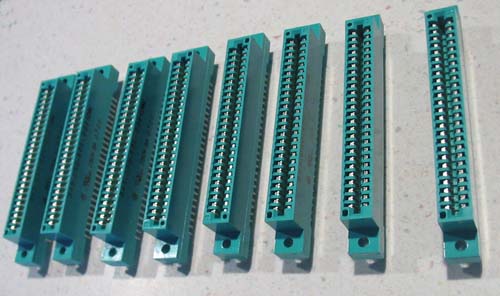My Apple II Rev 0 Replica
Project
Component Acquisition
I've put together a complete bill of materials along with suppliers. See an online BOM listing that includes example sources and costs. Sources and costs are constantly changing, but this listing provides you with a good idea of where parts can be found and how much they may cost. In order to find equivalent parts, I've had to resort to a variety of sources. The major sources I'm using are Digikey, Mouser and Jameco, but have bought parts from JDR, onlinecomponents.com. ACE and even ebay. There are several categories of components.
- IC's - I have found sources for all IC's except for ROMs, which will need to be scavenged off of an original Apple computer. Turns out that the individual vendors have many, but not all of the 74 series parts. However there is enough difference in selection between the major vendors, that I can find sources for most of these parts. Several parts are "new old stock". Several others recycled "clean pulls" (look like new to me). Others are newly manufactured replacement parts (the NTE company specializes in this).
- Sockets & connectors - I've been able to locate sources for form and functional equivalent sockets and connectors. One of the surprises here is the high cost of the 8 expansion slots. They cost $4.00 and up, and with eight them, the cost of these components amounts to the largest single percentage of the component cost. No wonder, it is said that Steve Jobs lobbied to eliminate them from the design. Pictured above is photo of eight of my first lot of green expansion slot connectors. For the sockets, I've upgraded to much more expensive milled sockets which should prove to be far more reliable than the flakey sockets that Apple used.
- Discrete components - I've been able to locate sources for form and function equivalent discrete components.
- It's been difficult to find a good crystal. For color to work, the Apple II must generate an accurate color burst. The 14.318 MHz crystal must generate a very accurate frequency in this circuit for this purpose. I've had to buy lots of 6 different versions of this crystal from several different manufacturers, in order to find one that reliably works. Four of the parts would not generate a good enough color burst at all. With one of the designs, about 25% of the parts would work. During this search, I made a desperate purchase of a half dozen each, of 4 different crystal designs. One of these parts turned out to be what I needed.
- More than 2/3rds of the NTE 74166's that I have received, from 2 different suppliers, don't work. I've recently found a source of new old stock 74166s on ebay and am buying a lot of them, in order to avoid those NTE parts.
- One vendor has sent me the wrong parts, on two different occassions.
- Some parts are apparently single source. I've bought a slightly larger supply of some of those parts, in case the source stops production. In particular, the 5-60pF cap from Jameco seems to be the only one out there with specs similar to Apples. The 74166 has been trouble because of DOA issues and I only could find the 74S195s at JDR.
- The green card edge connectors have been slow to get, because of the need for my supplier to backorder them from the manufacturer.
- One lot of 2513 character ROM's that I purchased, had different "^" and ":" characters than the ones used by Apple. Those 2513's are now in my reserve stock. Current stock which I bought later on, from a different vendor appears to have an Apple equivalent character set.
Back to Mike's Hobby Home Page
